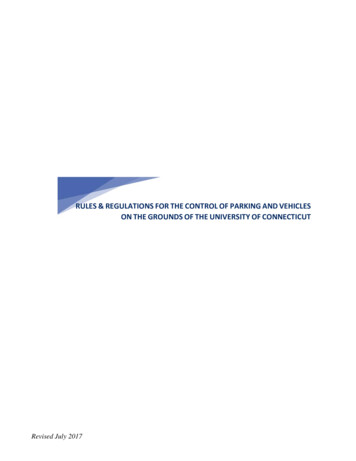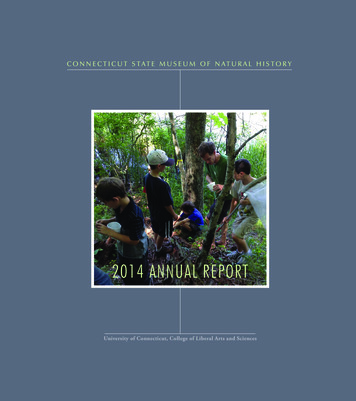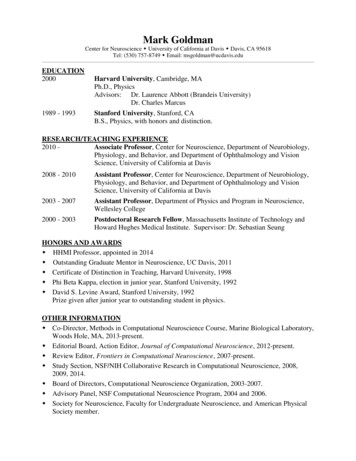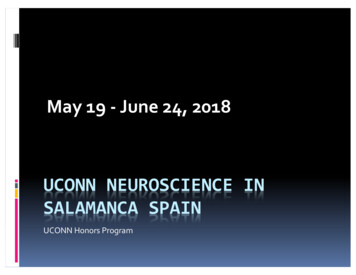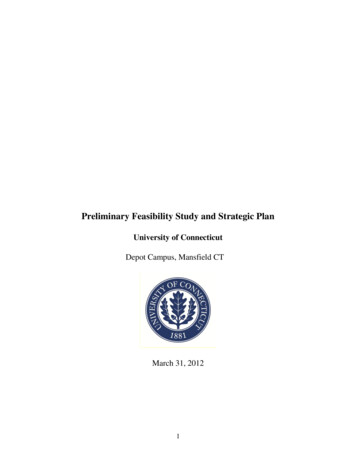
Transcription
An event organized bythe UCONN Interdisciplinary NeuroscienceProgram Steering Committeewith the support of theUCONN OVPR Scholarship Facilitation Fundand the contribution of the departments of24th AnnualNeuroscienceat StorrsBiomedical EngineeringPharmaceutical SciencesPhysiology and NeurobiologyPsychological SciencesFor info -storrs-rsvp/Dodd Konover Auditorium /Bousfield Psychology Atrium3:30 – 8: 30 pm
Program3:30–4:15 pm: Data Blitz . page 3The Data Blitz is a fun way for trainees to present theirresearch in a concise manner to a diverse audience byencapsulating their work in a 3-minute-long presentation andlimited to only 3 PowerPoint slides. The bell will be rung at theend of the 3 minutes. There will be 2 minutes for Q & A.4:30–6:00 pm: Keynote Lecture . page 2Ed Boyden, PhDMIT / Howard Hughes Medical Institute“Tools for Analyzing and Repairing the Brain”6:30–8:30 pm: Poster Session . page 5During the poster session, Ph.D. students, postdoctoral fellows,and researchers from across campus will present their work inposter format. Everybody is welcome to interact informally overfood and drinks!
WELCOME TO THE 24th ANNUAL NEUROSCIENCE AT STORRS, 2022!After two years of dramatic adjustments in our lives due to COVID, the annual Neuroscience at Storrs symposium returns as one of the first post-pandemic in person scholarly event at UConn!This is a unique opportunity to bring together the diverse neuroscience researchcommunity from across several schools and departments at University of Connecticutand UConn HEALTH. It is also an opportunity to welcome colleagues and traineesfrom fellow programs and research communities across the entire New England regionand to facilitate new exchanges and collaborations.Neuroscience at Storrs provides a venue for faculty, postdoctoral fellows, and students (both graduate and undergraduate!) to meet and share their research, discuss new ideas,and attend a guest lecture describing innovative, groundbreaking research in the field.This year, we are fortunate to have Prof. Ed Boyden from the Massachusetts Instituteof Technology as our keynote speaker.This year’s Steering Committee is comprised of Profs. Heather Read and John Salamone (Psychological Sciences), Dr. Alex Jackson (Physiology & Neurobiology), Dr.Greg Sartor (Pharmaceutical Sciences), and Dr. Sabato Santaniello (Biomedical Engineering). Organizers are Drs. Bin Feng, Martin Han, and Sabato Santaniello (BiomedicalEngineering), Dr. Yongku Cho (Chemical & Biomolecular Engineering), and Prof.Monty Escabì (Biomedical Engineering and Electrical & Computer Engineering).This event is made possible with the support of the University of Connecticut Officeof the Vice President for Research Scholarship Facilitation Fund and the support of thedepartments of Biomedical Engineering, Psychological Sciences, Pharmaceutical Sciences, and Physiology & Neurobiology at the Storrs campus.
KEYNOTE LECTUREDodd Konover Auditorium, 4:30 pmEd Boyden, PhDProfessor, Massachusetts Institute of TechnologyInvestigator, Howard Hughes Medical Institute“Tools for Analyzing andRepairing the Brain”Abstract. Understanding and repairing complex biological systems, such as the brain, requires technologies for systematically observing and controlling these systems. We are discovering new molecularprinciples that enable such technologies. For example, we discovered that one can physically magnifybiological specimens by synthesizing dense networks of swellable polymer throughout them, and thenchemically processing the specimens to isotropically swell them. This method, which we call expansionmicroscopy, enables ordinary microscopes to do nanoimaging – important for mapping the brainacross scales. Expansion of biomolecules away from each other also de-crowds them, enabling previously invisible nanostructures to be labeled and seen. As a second example, we discovered that microbial opsins, genetically expressed in neurons, could enable their electrical activities to be preciselycontrolled in response to light. These molecules, now called optogenetic tools, enable causal assessment of how neurons contribute to behaviors and pathological states, and are yielding insights intonew treatment strategies for brain diseases. Finally, we are developing, using new strategies such asrobotic directed evolution, fluorescent reporters that enable the precision measurement of signals suchas voltage and calcium. By fusing such reporters to self-assembling peptides, they can be stably clustered within cells at random points, distant enough to be resolved by a microscope, but close enoughto spatially sample the relevant biology. Such clusters, which we call signaling reporter islands (SiRIs),permit many fluorescent reporters to be used within a single cell, to simultaneously reveal relationshipsbetween different signals. We share all these tools freely and aim to integrate the use of these tools toenable comprehensive understandings of neural circuits.Biography. Ed Boyden received B.S. degrees in physics and electrical and computer engineering andM. Eng. degree in electrical and computer engineering from the Massachusetts Institute of Technologyin 1999. He received a PhD in neurosciences from Stanford University in 2005 and returned to MITin 2006. He is now the Y. Eva Tan Professor in Neurotechnology at MIT and Professor in Brain andCognitive Sciences, with joint appointments in the Program in Media Arts and Sciences and the Department of Biological Engineering. Ed was selected to become a Howard Hughes Medical Instituteinvestigator in 2018 and 2020, has been awarded the NIH Director’s Transformative Research Awardthree times (2012, 2013, and 2017), and received an NIH Director’s Pioneer Award in 2013. Ed is amember of the National Academy of Sciences, the American Academy of Arts and Sciences, theAmerican Institute for Medical and Biological Engineering (AIMBE) College of Fellows, and the National Academy of Inventors.2
DATA BLITZ SESSIONDodd Konover Auditorium, 3:30 pm – 4:15 pm1. Dea Gorka (gorka@uchc.edu), Graveley’s Lab, UConn HEALTH Biomedical Eng.Silencing of Paternal UBE3A by UBE3A-ATS Occurs throughTranscriptional Interference2. Ramalakshmi Ramasamy (ramalakshmiramaswamy@gmail.com), Smith andCrocker’s Labs, UConn HEALTH NeuroscienceCuprizone-Mediated Demyelination Reversibly Degrades Voiding Behavior in Mice while Sparing Brainstem Reflex3. Yang Song (yang.song@uconn.edu), Zhang’s Lab, UConn Biomedical EngineeringMultiplex Neurochemical Sensing via Electrografting-EnabledSite-Selective Functionalization of Graphene Field-Effect Transistors4. Guangfu Wu (guangfu.wu@uconn.edu), Zhang’s Lab, UConn Biomedical Eng.Wireless, Battery-Free Push-Pull Microsystem for MembraneFree Neurochemical Sampling in Freely Moving Animals5. Chuyi Su (chuyi.su@uconn.edu), Swadlow’s Lab, UConn Psychological SciencesCorticotectal Neurons and Putative Fast Spike Interneurons:Distinct Properties of Two Types of Complex Cells in Layer 5of Primary Visual Cortex6. Ryan Troha (ryan.troha@uconn.edu), Markus’s Lab, UConn Psychological SciencesA Novel Behavioral Paradigm for Examining ObservationalLearning in Rats3
7. John Zhou (jzhou@uchc.edu), Yan’s Lab, UConn HEALTH NeuroscienceBace-1 Regulates Expression of Clusterin in Astrocytes for Enhancing Clearance of β-amyloid Peptides8. Pengyu Zong (zong@uchc.edu), Yue’s Lab, UConn HEALTH NeuroscienceFunctional Coupling of TRPM2 with Extrasynaptic NMDARsExacerbates Excitotoxicity in Ischemic Brain Injury4
POSTER PRESENTATIONSBousfield Psychology Building, Atrium, 6:30 pm – 8:30 pm* Posters are listed according to the Board ID on which they are displayed1. Yi Huang (PNB, yi.2.huang@uconn.edu)Neuroanatomical and functional analysis of lateral hypothalamic GABAergic neurons -dorsalpons circuits in stress and arousal behavior2. Christopher Babigian (Psych Sci, christopher.babigian@uconn.edu)A role for BD2-selective BET inhibitors in cocaine-seeking behaviors3. Hujie Li (BME, huijie.li@uconn.edu)Microneedle-based potentiometric sensing system for continuous monitoring of multiple electrolytesin skin interstitial fluids4. Pengyu Zhong (UConn HEALTH Neuroscience, zong@uchc.edu)Functional coupling of TRPM2 and extrasynaptic NMDARs exacerbates excitotoxicity in ischemic brain injury5. Ramalakshmi Ramasamy (UConn HEALTH Neuroscience, ramalakshmiramaswamy@gmail.com)Cuprizone-mediated demyelination reversibly degrades voiding behavior in mice while sparingbrainstem reflex6. Gayle Edelstein (Psych Sci, gayle.edelstein@uconn.edu)Detailed characterization of the effects of the vesicular monoamine transporter-2 inhibitor tetrabenazine on effort-based decision making and binge-like eating: exertion of effort vs. “anhedonia”7. Alev Ecevitoglu (Psych Sci, alev.ecevitoglu@uconn.edu)Modeling treatments for effort-related motivational dysfunction: Assessment of novel atypical dopamine transport inhibitors5
8. Alexandria Battison (PNB, alexandria.battison@uconn.edu)Presynaptic local proteomes from three GABAergic interneuron cell-types are identified throughantibody-based proximity labeling9. Emily Fabrizio-Stover (UConn HEALTH Neuroscience, fabriziostover@uchc.edu)Evidence of tinnitus-specific differences in stimulus evoked brainstem potentials10. Suzannah De Almeida (Pharm Sci, suzannah.de almeida@uconn.edu)BET proteins as novel epigenetic targets for the treatment of opioid use disorder11. Dea Gorka (UConn HEALTH BME, gorka@uchc.edu)Silencing of paternal UBE3A by UBE3A-ATS occurs through transcriptional interference12. Garrett Frady (Statistics, garrettfrady2@gmail.com)Predicting early onset of mental-related illnesses using Bayesian feature extraction methods on locations of the brain13. Alpaslan Ersoz (BME, alpaslan.ersoz@uconn.edu)A 16-channel bidirectional neurostimulator system for simultaneous recording and stimulation14. Xu Zhang (BME, xu.3.zhang@uconn.edu)Transcranial direct current stimulation of cerebellum alters spiking precision in cerebellar cortex:A modeling study of cellular responses15. Rosangela Platt (Psych Sci, rosangela.platt@uconn.edu)Pronounced differences in retinotopic scatter between putative inhibitory and excitatory neurons inrabbit visual cortex16. Qingli Hu (Psych Sci, qingli@uconn.edu)Effects of ultrasonic vocalizations on rat behavior and place cell remapping in the hippocampus17. Alexandria Pacrin (PNB, alexandria.pacrin@uconn.edu), “”6
the UCONN Interdisciplinary Neuroscience Program Steering Committee . from fellow programs and research communities across the entire New England region . He received a PhD in neurosciences from Stanford University in 2005 and returned to MIT in 2006. He is now the Y. Eva Tan Professor in Neurotechnology at MIT and Professor in Brain and



